This is the Fujica Fujicarex II, a 35mm SLR camera produced by Fuji Photo Optical Co., Ltd. starting in 1963. It uses a Citizen central leaf shutter, and has shutter priority automatic exposure via the selenium exposure meter mounted in front of the prism. Although not a true interchangeable lens camera, the front lens group can be swapped with a wide angle and telephoto lens grouping, changing the focal length of the lens. A curious feature of the camera is that both focus and exposure controls are all done via two wheels on the back plate of the camera, rather than around the lens. The Fujicarex II was the export version of an earlier Fujicarex but the two cameras are identical.
Film Type: 135 (35mm)
Lens: 5cm f/1.9 Fujinon-S coated 6-elements
Lens Mount: Fujicarex Front Group Bayonet
Focus: 2 feet to Infinity
Viewfinder: Fixed SLR Pentaprism with dual split image focus aide
Shutter: Citizen-QR Leaf
Speeds: B, 1 – 1/500 seconds
Exposure Meter: Coupled Selenium Cell w/ viewfinder match needle
Battery: None
Flash Mount: Coldshoe and M and X Flash Sync
Weight: 901 grams (w/ lens), 845 grams (body only)
Manual: https://www.cameramanuals.org/fuji_pdf/fujicarex_ii.pdf
How these ratings work |
The Fujicarex II was Fuji’s earliest attempt at an SLR and it shows. It’s central leaf shutter was consistent with other consumer lever SLRs of the time, but with a combination of some very strange ergonomic choices, it sold poorly. While I generally appreciate cameras with strange quirks, in use the Fujicarex takes some getting used to. It’s a solid camera when you can find one in working condition and the images you’ll get from it will be very good, but it’s not a camera I would recommend as a first, second, or even tenth camera to search for if you were first getting into this hobby. | ||||||
| Images | Handling | Features | Viewfinder | Feel & Beauty | History | Age | |
| 2 | 0 | 1 | 2 | 2 | 0 | 20% | |
| Bonus | none | ||||||
| Final Score | 8.4 | ||||||
History
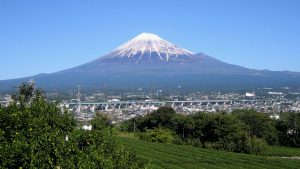
The name “Fuji” comes from Mount Fuji, which is the tallest mountain on the island of Japan. At a height of 3,776 meters, it is only the 35th tallest mountain in the world, but is still considered to be a source of inspiration and reverence to the Japanese people. As such, the name “Fuji” has been repeatedly used in the names of several companies, from Banks, Steel Companies, and several electronics companies.
The Fuji company that produced a number of film cameras in the middle of the 20th century dates back to 1934 when it was formed as Fuji Photo Film Co., Ltd. This company was an offshoot of an earlier Japanese company called the Dai-Nippon Celluloid Company who was formed in 1919 as Japan’s premiere maker of celluloid film and other products.
Fuji’s earliest products were photographic film, but it didn’t take them long to start producing other optical products such as cameras and lenses.
In the early 1940s, Fuji would expand their operations and begin making optical products solely for the Japanese military. In my research for this article, I could find very little information about what types of products these were, but most likely they were lenses for scopes, binoculars, and other war-time products.
After the war, Fuji would reorganize into several smaller divisions, all managed under the same corporate umbrella, but what little I could find on it was hard to follow. As best as I can tell, these separate Fuji companies would all fall into a single entity known as the Fujifilm Group.
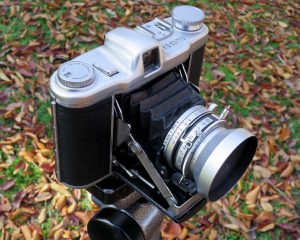
In 1948, Fuji would release it’s first camera, a medium format folding camera called the Fujica Six which would shoot 6cm x 6cm images on 120 roll film. Fuji likely followed the trend of combining it’s own name with a ‘-ca’ suffix from ‘camera’ to come up with Fujica, just like Leica, Konica, and Nicca had done.
The Fujica Six would most closely resemble other German 6×6 medium format folding cameras like the Zeiss-Ikon Nettar and the AGFA Isolette. It was a pretty successful model, spawning several variants and staying in production until at least 1953.
During the 1950s, Fuji would experiment with several other roll film cameras like the Super Fujica Six, the Fujicaflex TLR and later a variety of medium level 35mm rangefinder cameras like the Fujica 35-ML, but their focus was still on photographic film.
By the early 1960s Fuji had dipped their toe into pretty much every style of photographic camera, from medium format folding cameras, twin lens reflexes, low to medium end rangefinders, half frame cameras, and even considered a 16mm SLR camera, but one style they had yet to release was a 35mm SLR.
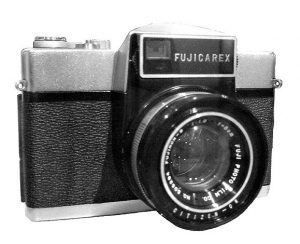
In 1962 at a Japanese Camera Trade show, possibly in Chicago, Fuji would announce a new 35mm SLR prototype called the Fujicarex. Very little is known about this prototype camera other than it would have a Fujinon-S 5cm f/1.9 lens, what looked to be some kind of small light meter on a prominent Fujicarex name plate in front of the prism, a Citizen-QR leaf shutter, and a rapid advance wind lever.
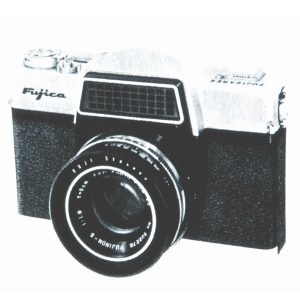
Most sources of information about this camera say that later that same year, the camera would go on sale in Japan as the Fujicarex with most of the same features as that prototype with the sole exception being a redesigned selenium exposure meter.
The image to the right is the only one I could find of a camera that might be the original Fujicarex. It looks identical to the Fujicarex II with the only difference being the lack of “II” beneath the name on the top plate and different text on the black ring around the lens.
At some point in 1963, an export model for the United States possibly called the Fujicarex SLR 35 was announced, but all evidence I’ve seen suggest that the camera was sold as the Fujicarex II. I’ve never seen any kind of documentation, marketing material, or evidence that a camera called the SLR 35 was ever sold. What differences there are between an original Fujicarex, the rumored Fujicarex SLR 35, and the Fujicarex II that was actually sold is unclear.
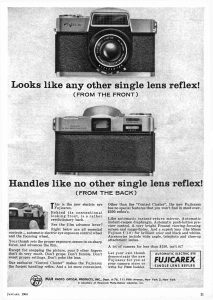
The ad to the left from January 1964 lists the price of the Fujicarex at “under $150” which likely means $149.50, which when adjusted for inflation, compares to about $1250 today making it quite an investment for someone looking for a camera that attempted to reinvent the user interface of a 35mm SLR.
It does not seem like the Fujicarex was a success in either Japan or the United States. It is not often that a Japanese made camera is sold exclusively in the United States, unless it was made for a specific reason. It turns out that making a camera that looks like any other SLR, but handles like no other SLR was not a good thing as people likely struggled with it’s controls.
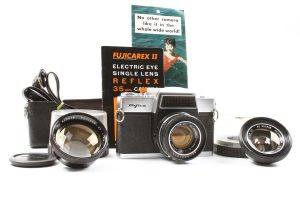
Whatever the case, the Fujicarex seemed to disappear from the market in 1965 and would be the company’s only 35mm SLR until the Fujica ST701 in 1971. I have no idea how many of these cameras were ever produced, but the number has got to be small. Taking a look at eBay, there are currently only two for sale on the entire site, which suggests a pretty small sample size.
Although the Fujicarex wasn’t very successful, the company would continue to have success in the decades to come, most recently as one of the world’s most popular makers of digital mirrorless cameras. In fact, the camera that I’ve used to shoot all the cameras that I’ve reviewed on this site since mid 2018 is the Fujifilm X-T20 digital mirrorless. It’s excellent combination of performance, color accuracy, and classic styling is what won my purchasing dollars over competing models from other companies.
Today, the Fujicarex is hardly collectible. I’d wager that many people never even know it existed. It’s rarity, low value, and strange control scheme don’t make it much of a target, but for anyone who just happens to like odd ball cameras that weren’t successful, it might be right up your alley!

My Thoughts
I’ve had pretty good luck with Fujica cameras. When I reviewed the Fujica 35-ML, the Fujica 35 Automagic, and the Fujica Drive, I consistently came away impressed both with the performance of each camera, and the ways in which Fuji did things just a little different from everyone else.
I first became alerted to the existence of the Fujicarex in early 2018 when I saw one for sale in a lot of cameras that went far higher than I was willing to spend, so I casually placed it on my radar waiting for an opportunity to pick one up at an affordable price. Due to the model’s relative obscurity, it would take me over a year before one would finally show up in late 2019. It was pretty dirty and strangely, the entire prism was loose inside of the top plate, but a quick removal of the camera’s top plate allowed me to set it back in it’s correct position and I found the rest of the camera seemed to work well.
As you might expect from a fully mechanical SLR from the early 1960s, the Fujicarex is quite heavy. At 901 grams with the standard 5cm f/1.9 lens, this is a camera you’d definitely feel hanging from your neck on a long trip to the zoo…which is exactly how I used it.
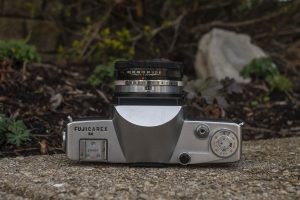
From the moment you look at the Fujicarex, you can clearly see it’s not like most other SLRs. Starting with the top plate, we see a built in accessory shoe off to the left, beneath the Fujicarex II logo. The inclusion of an accessory shoe by itself is not anything special, but having one built into the top plate of an early 1960s SLR is quite unusual as the more common method of adding some type of clip on shoe over the pentaprism like the Pentax Spotmatic, or one that slides over the rewind knob such as the Nikon F and Topcon RE, was much more prevalent at this time.
The hump over the pentaprism is also unique in that it has a distinct sweeping curve instead of more traditional angled edges. This doesn’t necessarily mean the pentaprism itself is curved, it just looks cool.
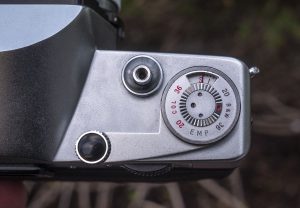
To the right of the pentaprism is the rapid wind lever with combined film reminder disc and automatic resetting exposure counter. Above the wind lever is the cable threaded shutter release button.
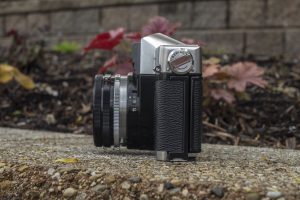
If you’ve ever handled any of Fujica’s late 50s or early 60s rangefinders, you’ll notice that the Fujicarex shares those model’s side mounted rewind knob. It’s like a normal top mounted rewind knob with a flip out handle, except on the side. This location is how Fuji was able to find space for the built in accessory shoe. It’s not easy to see in this picture, but at the very bottom of this side of the camera is the release latch for opening the rear film door.

The right hinged film door reveals a very ordinary looking film compartment. Film loads from left to right onto a double slotted and fixed take up spool. There is a notch on the base of the supply side which means you don’t have to pull up on the fork to insert a new cassette. The film pressure plate is both over sized and contains divots, which both help in maintaining film flatness with as little resistance as possible. There is also a roller on the left side of the door to help maintain flatness as the film travels over the sprockets. Finally, as the Fujicarex is a leaf shutter SLR, you can see the capping plate blocking light from entering the film gate.
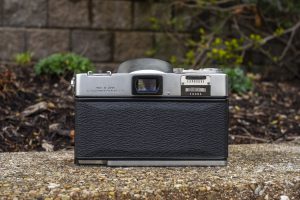
The back of the camera is notable as it contains what Fuji refers to as the “Control Cluster” which puts two horizontal wheels in the position roughly of where your right thumb would rest with the camera to your eye. On previous Fujica rangefinders, a single wheel is found in this location to control focus, which Fuji may or may not have borrowed from the Voigtländer Vitessa, but on the Fujicarex, a second wheel controls the aperture in the lens. The idea with this is that with the camera to your eye, you can precisely focus your image and using the exposure readout in the viewfinder, set correct exposure too.
The focus wheel on the back of the camera does not have any marked focus distances to see what you’ve chosen. For that, you need to look at one of two small windows near the 2 o’clock and 10 o’clock position around the shutter mount.
At the 2 o’clock position, you can see the selected distance in feet, and at the 10’clock position, you can see it in meters. Both of these scales move in unison as you turn the focus wheel on the back of the camera.
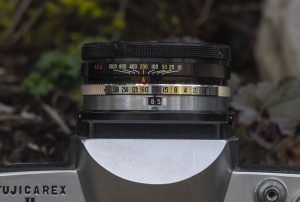
The Fujicarex uses a Copal leaf shutter and like nearly all leaf shutters, speeds are changed using a ring that goes around the shutter. Speeds from 1 to 1/500 second plus Bulb are available at all times. Like most cameras of the era, the metering system couples shutter speeds to f/stops like in an EV or LVS, except there aren’t any light value numbers anywhere on the lens. With the camera set to 1/60 and f/8, changing the shutter speed to 1/125 or 1/30 automatically selects f/5.6 or f/11 respectively so that the exposure amount remains the same.
The metering system on the Fujicarex is always on, and assuming you have a camera with a working meter, a needle visible in the viewfinder is always making recommendations. Although the Fujicarex does not have any automatic exposure modes, it works very much like a Shutter Priority AE system in which you first select a shutter speed around the lens that corresponds to the type of film and lighting that you will most likely use the camera in. Then, using the reading of the meter in the viewfinder, you use the exposure wheel on the back of the camera to change f/stops. Think of it sort of like a Shutter Priority Semi-AE in that you first set the shutter speed, then use the meter and the exposure wheel to correctly dial in an appropriate f/stop.
In practice, this actually works quite well, and I prefer this system to the many combinations of EV and LVS systems that are in place on many 1950s and 60s cameras in which I feel you have to fight for control over the camera. For best results while shooting outdoors using ASA 100 speed film, set the shutter speed to 1/125 and then keep your thumb on the exposure wheel while watching the needle in the viewfinder and the entirety of your roll should come out properly exposed.
The viewfinder is one of the best features of the camera. The view through the finder is large and bright from corner to corner. The focusing screen has a Fresnel pattern which not only maintains brightness at the corners, it also means that the entire screen can be used for focusing, unlike other leaf shutter SLRs like the Zeiss-Ikon Contaflex in which only the center of the viewing screen can show focus which goes down to 2 feet. I don’t know what Fujica’s secret was, but this is one of the brightest and most evenly lit focusing screens on any Fresnel equipped cameras I’ve seen.
In the gallery above, I show two images of the viewfinder, one in focus and the other intentionally out of focus to show off the unique double split image focusing aide. It’s like any other split image focusing aide, except instead of the line breaking once, it breaks twice. Notice how the middle section of the utility pole in the out of focus image is shifted.
On the right side of the viewable image is the meter readout. A black needle points to an Over / Under scale with a rectangular line in between. As long as the needle is pointing to any section of the rectangular line, your image will be correctly exposed.
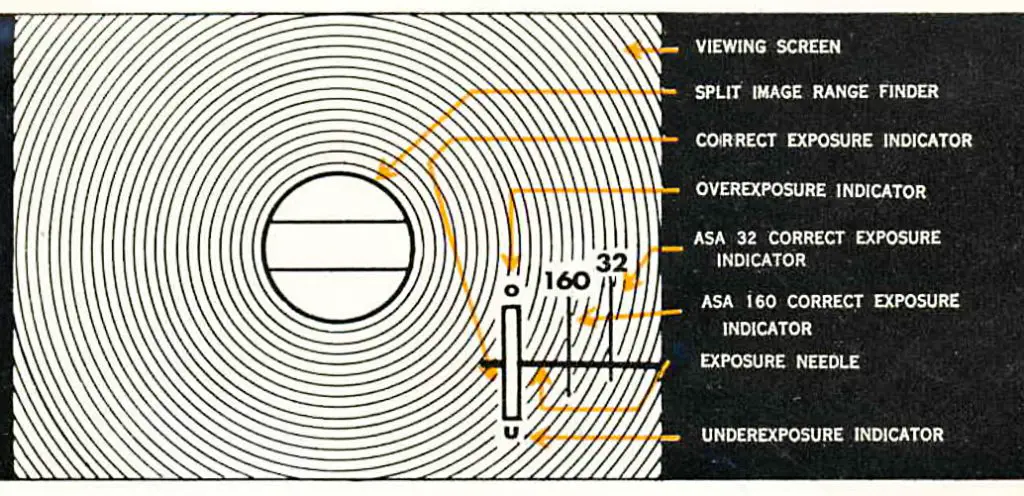
There are two additional lines marked 160 and 32 above them which are there to compensate for using ASA 32, 64, and 160 speed films, as the ASA selector ring around the shutter does not have positions for these speed films. According to the manual, when using ASA 32 or 64 speed film, you are to choose the ASA 50 or 100 settings on the camera, and then use the curved line under the number 32 to indicate proper exposure. For ASA 160 speed film, you choose the setting for 200 and then use the curved line under the number 160 to indicate proper exposure. Why Fuji couldn’t have just included settings for these three speeds of film is anyone’s guess and although not that difficult to understand, somewhat negate what would have been a pretty well thought out metering system.
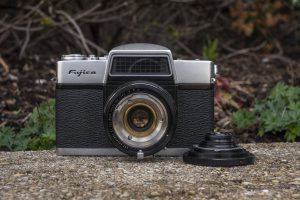
Although not a true interchangeable lens SLR, the Fujicarex did offer two auxiliary lenses that replace the front lens grouping similar to the Kodak Retina IIc or the Zeiss-Ikon Contaflex. The two available lenses were a 35mm f/4 wide angle and an 80mm f/2.8 telephoto.
To swap lenses, you must press a bent metal finger at the 6 o’clock position at the base of the lens in the direction of the red arrow, while turning the front lens grouping counterclockwise. The front grouping uses a bayonet mount that is unique to this camera, and is re-installed in the opposite of how it is taken off.
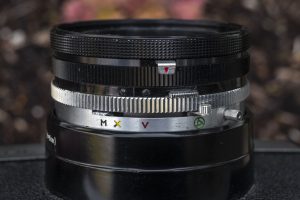
Also near the bottom of the lens are two sliders, one that controls both M and X flash sync, but also enables the self timer (the “V” position), but there is a second slider that functions as a depth of field preview. Normally this second lever is next to a circular green icon that sort of looks like an iris, but moving it to the left, away from this icon, momentarily will stop down the iris to show a depth of preview within the viewfinder. Although this feature would become common focal plane SLRs in the decades to come, it was not a commonly found feature on leaf shutter SLRs like this.
The Fujicarex is a neat looking camera with an excellent viewfinder, an excellent lens, and a unique layout of controls that should mean it’s a lot of fun to shoot, but was it?
My Results
I was reasonably confident the Fujicarex was in excellent working condition for it’s first roll, so I loaded in a fresh roll of Kodak Ektra 100 which has a reputation as not having the most latitude for over or under exposure, compared to other color films. I took it with me on a family trip to the zoo, thinking that the large and bright viewfinder with unique double split image focusing aide would come in handy.
After shooting the Fujicarex and seeing the images I got from it, I was right about a lot of things, but wrong about one, but it’s a big one.
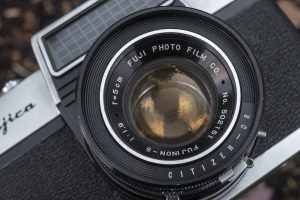
Starting with the good stuff, as seems to be the case with every Fujica camera I’ve shot, the optics are excellent. Fuji may have been a film first company that never reached the levels of respect that Nikon, Canon, Minolta, or any other A-list Japanese maker did, but they knew how to make good lenses. The 5cm f/1.9 Fujinon-S lens is as good as any from the era, and produced images that were sharp from corner to corner, showed excellent contrast and color reproduction, and lacked any of the usual anomalies found in lesser lenses.
The metering system also worked quite well with the camera. I shot about half the roll guessing Sunny 16 manually and the other half I relied on the recommendations that the meter gave. There’s a few shots that are over exposed by maybe half a stop, but for a nearly 60 year old camera that uses a selenium meter, it was very respectable.
I both liked and disliked the back plate focus and exposure wheels. While it makes perfect sense to keep both controls you’re going to need with the camera to your eye to control focus and exposure near your thumb, remembering to use my thumb to control them was a constant battle. Even when I did remember they were there, I often forgot which one was on top, focus, or exposure. I imagine that had this been my primary camera, that after a while I would have gotten used to it, and I applaud Fuji for thinking outside the box here, but there was nothing wrong with the method employed by nearly every other company. Throughout my first roll, my instincts regularly had me reaching for a focus ring on the lens. This is definitely a case of Fuji ‘fixing what’s not broken’.
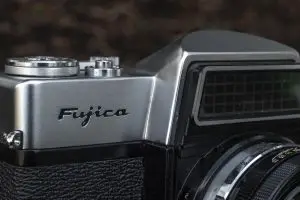
So far, the conclusions I’ve drawn are exactly what I would have predicted before I used the camera, but what surprised me is that I thought I would love the double split image focusing aide in the viewfinder more. I have very poor vision, and on earlier SLRs, I often struggle to see focus accurately and find myself drawn more to cameras with split image aides. The huge ones on early Exakta and Zeiss-Ikon SLRs are especially nice, so I thought if I liked one split image, then two might be better.
In reality though, I struggled more than I thought I would. I even missed focus on a few exposures that I wish I could have taken again. The issue is that while two splits might improve things, the circle itself is no bigger than on another SLR of the era. With the image splitting twice in a small area, it becomes harder to see, especially when taking fast motion shots. Sure, I could have zone focused, but that sorta defeats one of the benefits of an SLR.
It isn’t always clear why a product doesn’t find success. Sometimes the product itself was fine, but a combination of outside factors worked against it’s success. Maybe it was released at the wrong time, or maybe another product just happened to do something even better or cheaper. In the case of the Fujicarex, I feel as though Fuji is to blame for this one.
The Fujicarex is capable of making excellent photographs, and it feels good in your hands. My particular example was built well enough to still be operational nearly 60 years after it was built, but in their effort to make a camera that looks like any other SLR but handles like none other, they ended up with a product that no one wanted.
Related Posts You Might Enjoy
External Links
http://camera-wiki.org/wiki/Fujicarex_II
https://yashicasailorboy.com/2018/08/06/fujicarex-ii-by-fuji-photo-film-co-ltd/
https://ohnowhatdidisay.wordpress.com/2016/04/12/fujicarex-ii-flawed-innovation/
https://www.flickr.com/photos/tony_kemplen/albums/72157627186432015
https://www.fluidr.com/photos/tony_kemplen/sets/72157627186432015
https://fupduckphoto.wordpress.com/2020/02/06/the-fujicarex-ii/
http://web.archive.org/web/20190116175813/http://www.camera.portraits.srv2.com/fujicarex.htm

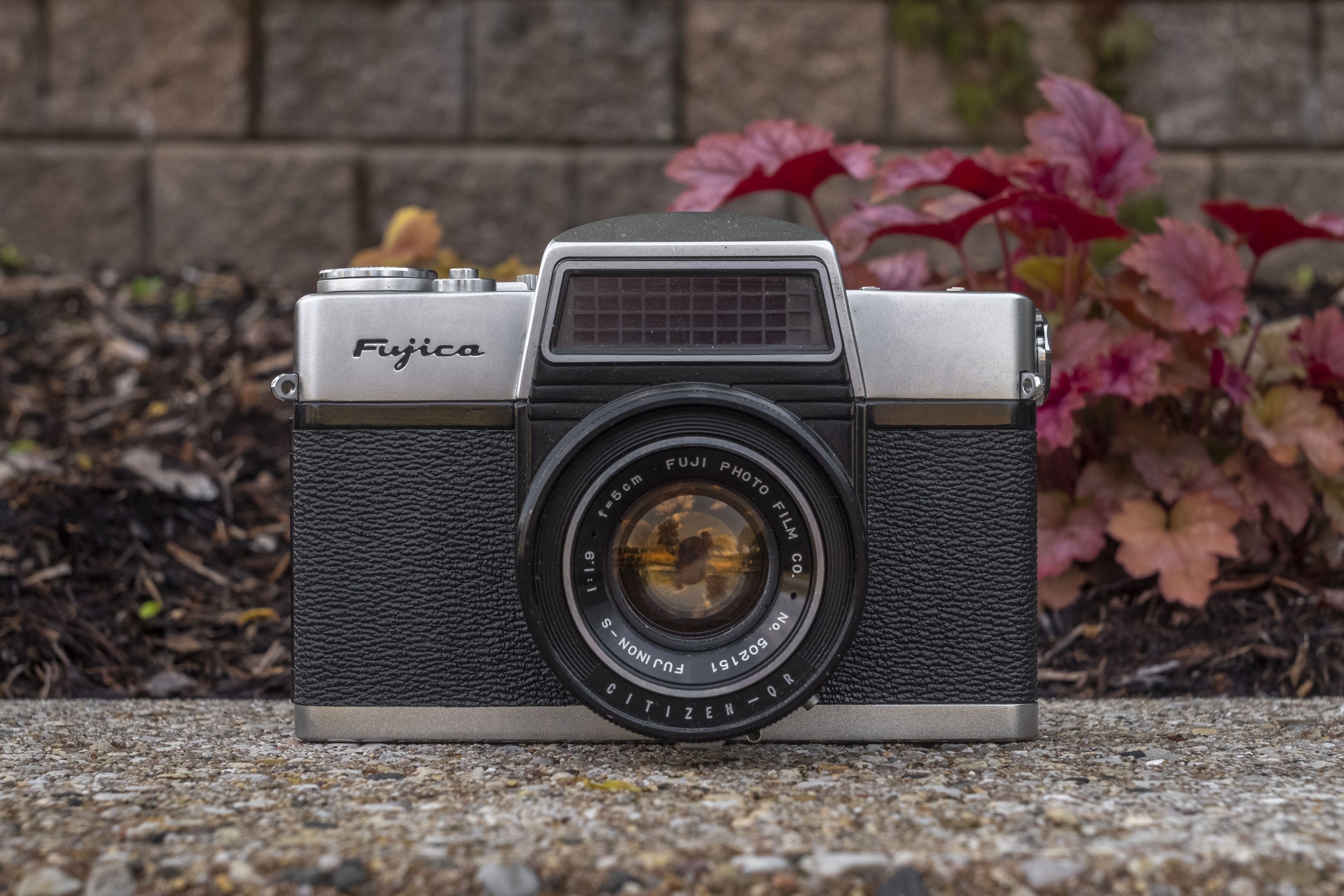
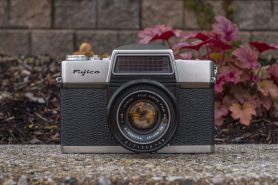
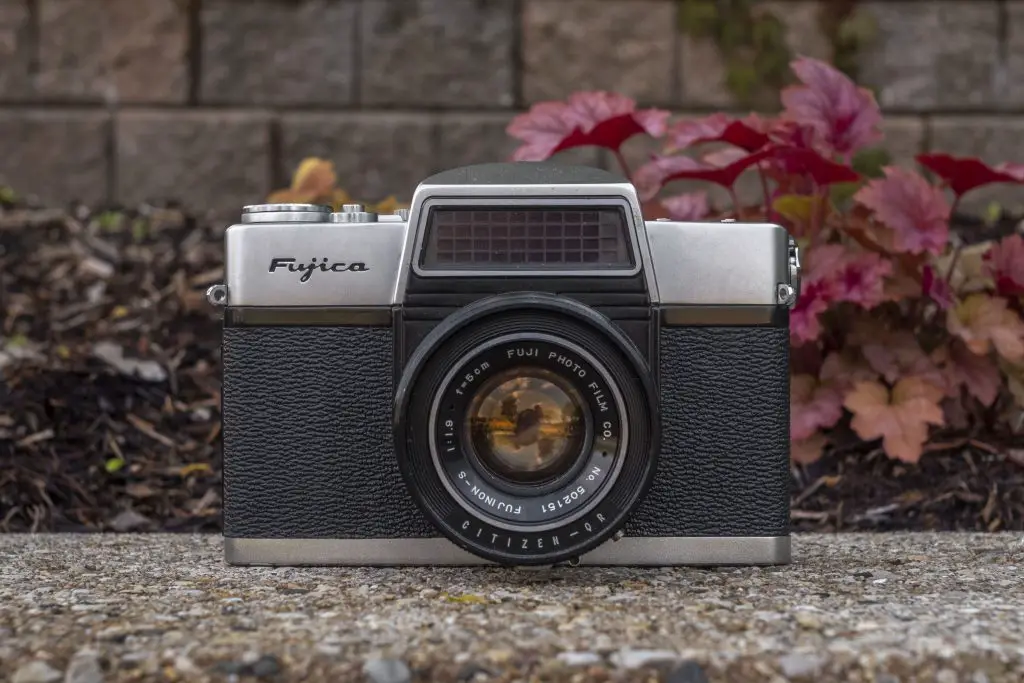
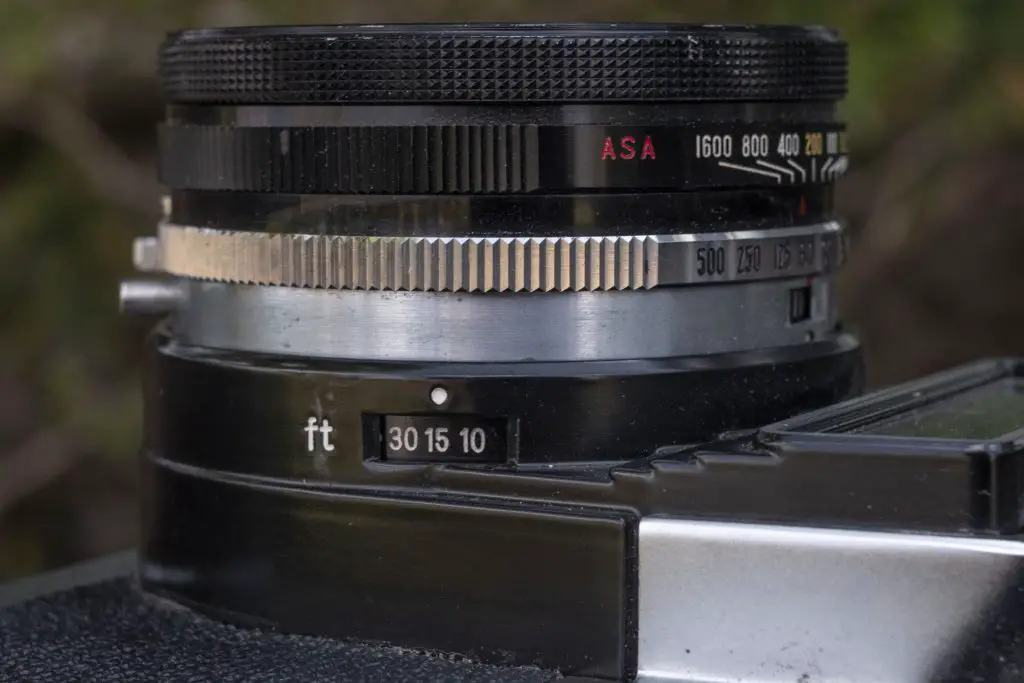
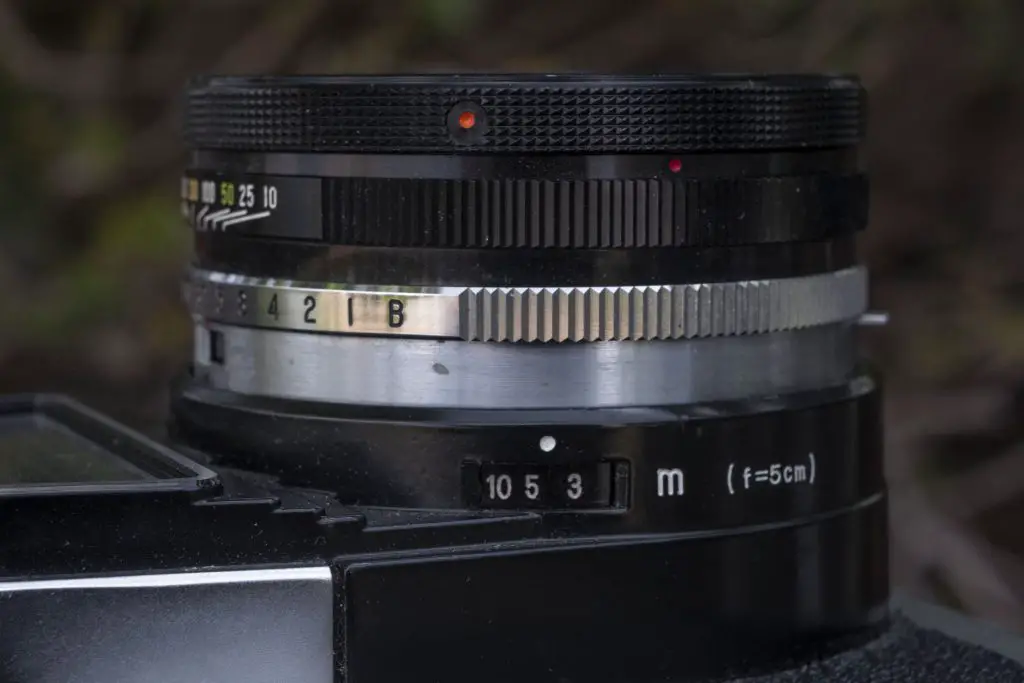
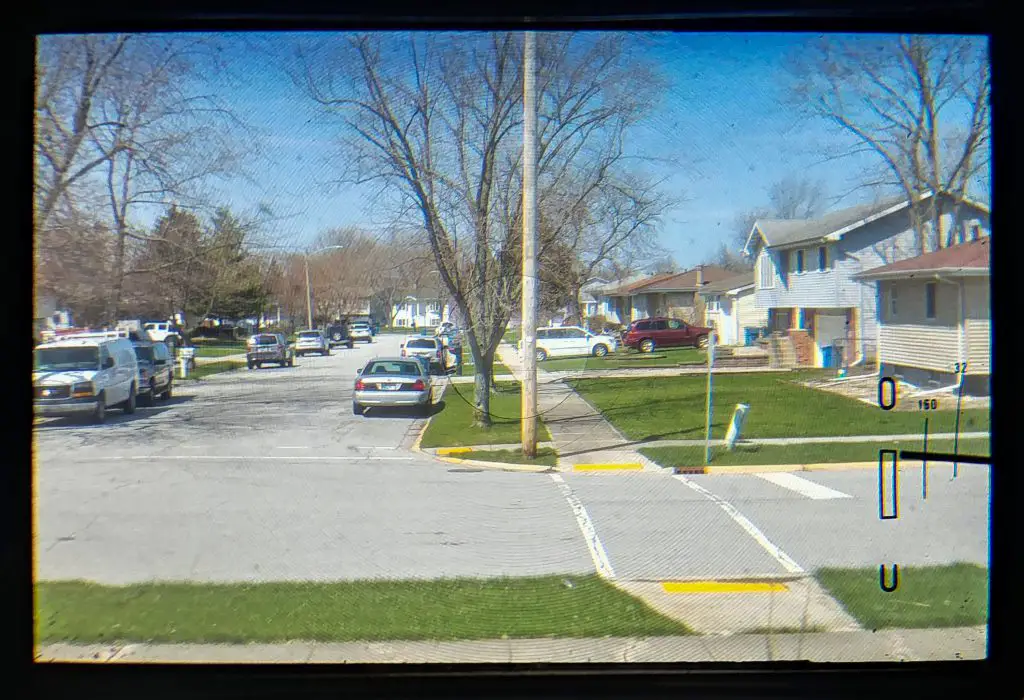
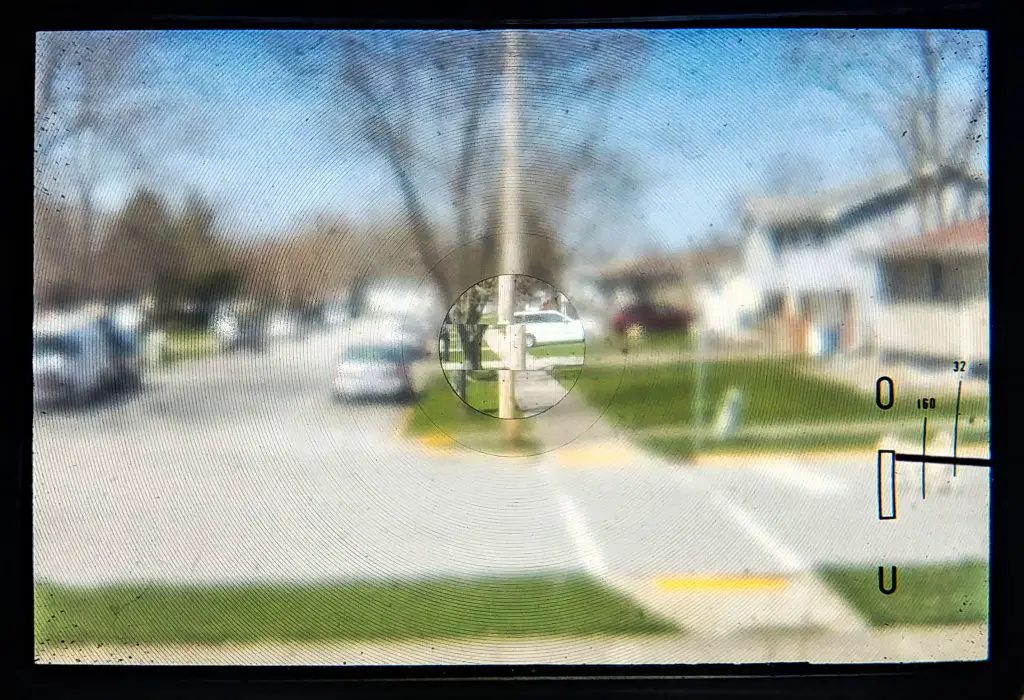


















Cool camera — it’s amazing that you had such luck with the selenium meter since the cell/window is not covered when not in use. I have had miserable luck with selenium meters (camera and handheld). And I have some fantastic old cameras with selenium meters that are “AE” — well they were when the selenium cell used to work — but without manual control they are useless. So it looks like this camera, despite the quirkiness, would still work “all manual” — even if the meter is not accurate or working. Time to go find one!!!! Thanks Mike!!!
Hi Dana. Yes, I got lucky with the meter on the Fujicarex. I’ve found that always exposed meters like the one here have a better chance of surviving if you can find the camera in it’s original case. Of course being in a case puts you at risk of other problems such as mold and mildew as those cases tend to trap that, so even that’s not a sure fire guarantee. Nevertheless, it did work, and the camera is fun to use.
And for your second question, I guess I pronounce it “foo-ji-kah-rex”. How do you pronounce it?!
Oh — I almost forgot — how do you pronounce “Fujicarex”????? 🙂
Weird — I am trying to reply directly to your comment to me Mike — but the Reply button does nothing. So I like “foo JHEE kah-rex” — with the heavy emphasis on the “JHEE.” 🙂 Although if you move the emphasis to the “REX” then it begins to sound like the name of a dinosaur…. 🙂
What type of film would you recommend for this camera? I need to get it soon(like within a week) 0_0 and I’m new to this so I don’t know! Thanks!
Hi Eliza! Although the Fujicarex can handle any kind of 35mm film made for today. I always like to start off safe with the first couple rolls through a new camera. For that, I would pick any black and white 100 speed film like Kodak TMax 100, or Ilford Delta 100! Good luck!
Well thanks for some info on this camera I have one in mint condition with 2 lens the book case flash it was my grandfathers looking at your images I think I will go and get myself a film and give it a go
Definitely give it a go! Fuji made many terrific cameras and their lenses always deliver!